Most types of mint plants are native to the Mediterranean region and belong to the Lamiaceae family. Each mint species has a unique flavor, aroma, and appearance. These distinctive features make it easier to identify 30 varieties of mint.
Peppermint, pennyroyal, apple mint, and chocolate mint are my favorite kinds of mint plants due to their refreshing flavors and aromas. Some species are used in cooking and baking, while others are in the manufacture of medicines.
You might be someone wondering which mint is best for tea or baking. Well, this comprehensive article will help you in the identification of different mint species from the descriptions and pictures.
Different Types of Mint Plants with their Pictures
Here are the most popular varieties of mint plants:
Apple Mint
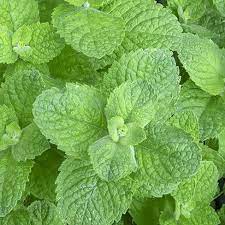
This mint species is also found in the Western and Southern parts of Europe. The refreshing flavors and aroma make this herb excellent for cooking.
The aroma from the leaves is slightly fruity with nuances of apple. You can eat fresh raw or cooked leaves to enjoy the flavors.
Apple mint can be used to make salads, add to cooked dishes, and prepare several kinds of tea. It also contains medicinal properties for treating flu, colds, stress, and fatigue.
Scientific Name |
Mentha suaveolens |
Common Names |
Pineapple mint, round-leaved mint, woolly mint |
Identification Features |
Large soft leaves and long stalks with a slightly fruity aroma. |
USDA Zone |
5-9 |
Peppermint
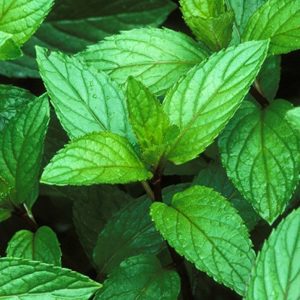
It is a hybrid mint species native to some parts of Europe and the Middle East. The Peppermint plant is a cross between water mint and spearmint.
The herb has a minty, uplifting, and pleasant aroma with numerous cooking and medicinal benefits. The antiseptic properties soothe inflammation and irritation caused by acne.
You can also use peppermint to soothe common colds, headaches, and digestive problems. The strong flavors can be used in salads and cooking dishes like meat.
Scientific Name |
Mentha x piperita |
Common Names |
M. aquatica x M. spicata |
Identification Features |
Strong taste and sweet aroma |
USDA Zone |
3-7 |
Chocolate Mint

Chocolate mint is a wonderful herb to add to your culinary kitchen garden. But the chocolate taste with sweet undertones makes people wonder if it is a mint plant.
The coco-colored stems and serrated leaves are the distinctive features of this kitchen garden culinary herb. I highly recommend this plant when baking cakes and cookies.
The plant is invasive and thrives well in a moist environment. We recommend planting the herb in pots or containers to compact its spreading ability.
Scientific Name |
Mentha x piperita f. citrata |
Common Names |
Chocolatey mint |
Identification Features |
Coco-colored stems and serrated leaves |
USDA Zone |
4 |
Hart’s Pennyroyal Mint
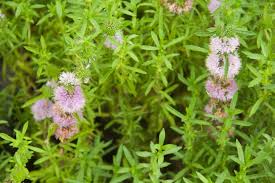
The herb thrives well in regions close to the Mediterranean Sea. You are likely to encounter this mint type in southwest France, Morocco, and Algeria.
The strong flavors and distinct scents are the distinctive features. Other additional features are the fine lance-shaped leaves and pale-blue lilac flowers.
The essential oil from this herb is ideal for culinary and medicinal purposes. It helps to heal nausea, respiratory problems, and digestive issues.
I recommend this herb when cooking traditional Portuguese fish and preparation of alcoholic beverages. You can also add to cheese, sauces, soups, and stews.
Scientific Name |
Mentha cervina |
Common Names |
Hyssop-leaved mint, narrow-leaved pennyroyal, stag mint, water spearmint |
Identification Features |
Fine lance-shaped leaves with pale-blue to lilac flowers. |
USDA Zone |
6-9 |
American Wild Mint
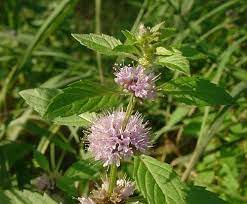
The mint type is native to North America, Europe, Western, and Central Asia. The high methanol content causes a sharp and penetrating mint scent.
The slightly bitter mint taste provides an excellent flavor for adding to salads and other cooked food. It also contains medicinal properties for preventing heart diseases.
You can also use the juice from the wild mint to soothe diarrhea and dysentery. The leaves help to relieve stomach pains and allergies.
Scientific Name |
Mentha arvensis |
Common Names |
Corn mint, field mint, Japanese peppermint |
Identification Features |
The sharp and penetrating mint scent |
USDA Zone |
3-8 |
Banana Mint
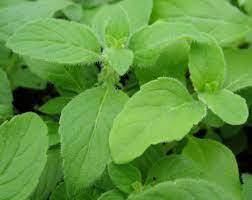
It is a fruity mint with a banana aroma that attracts bees to your garden and enhances pollination. The small lilac flowers are conspicuous in the summer.
The bright lime-green leaves are highly scented and spread fast. I recommend using banana mint in fruity salads, desserts, and making drinks.
Scientific Name |
Mentha arvensis |
Common Names |
Banana mint |
Identification Features |
Bright lime-green leaves with small lilac flowers |
USDA Zone |
5-11 |
Basil Mint
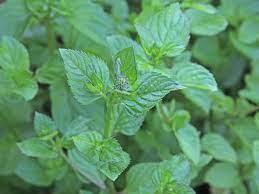
It is a hybrid type of mint with narrow leaves that produce mint and basil aromas. The herb is easy to grow and cultivate in North America.
I recommend using fresh basil mint leaves to enjoy the flavors. But you can dry the leaves for easy storage though the flavors will last up to six months.
Use the basil mint leaves in salads and make herbal teas. The inflammatory properties can relieve stomach upsets and headaches.
Scientific Name |
Ocimum basilicum |
Common Names |
Basil mint |
Identification Features |
Narrow leaves with mint and basil aromas |
USDA Zone |
4-9 |
Calamint
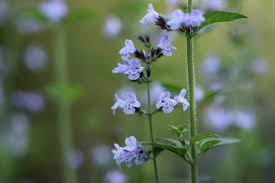
The mint species is native to the United Kingdom. It has broad fuzzy leaves with deep veins and thick stalks.
Calamint can grow up to 2ft tall with light pink flowers. The herb contains medicinal properties for treating bruises and contusions.
You can also use dried leaves of calamint to season your meat. It is the best alternative to basil and thyme herbs.
Scientific Name |
Calamintha nepeta |
Common Names |
Calamint |
Identification Features |
Large fuzzy leaves with deep veins and light pink flowers |
USDA Zone |
5-7 |
Catmint
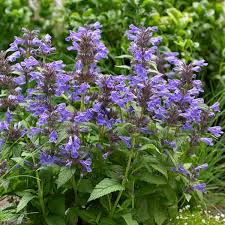
It is an ornamental herb commonly planted in vegetable gardens to repel pests. You can also use the herb as an edging plant along the borders due to its vibrant leaves.
The green-grey leaves and blue-lavender flowers are the distinctive features. The herb can be toxic to your furry feline since it might cause a euphoric feeling.
Use the leaves to add to the sauces and soups. If you’re suffering from coughing and nasal congestion, drink herbal tea made from catmint leaves.
Scientific Name |
Nepeta |
Common Names |
Catnip, catswort, catwort |
Identification Features |
Green-grey leaves with blue-lavender flowers. |
USDA Zone |
3-9 |
Corn Mint
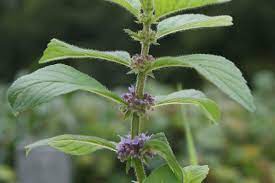
It is a wild mint native to the United States. The herb grows up to six and 18 inches tall in proper condition. The square stems produce small bunches of flowers every few inches.
You can use corn mint to prepare herbal tea and treat the common cold. Chewing fresh leaves can help clear nasal congestion and soothe coughs.
Scientific Name |
Mentha canadensis |
Common Names |
Cornfield mint |
Identification Features |
Square stems that produce small bunches of flowers every few inches |
USDA Zone |
4-7 |
Corsican Mint
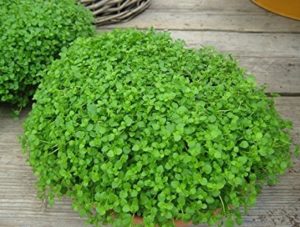
The low-growing or creeping mint type is native to Corsica. It is the smallest species with bright green oval-shaped leaves.
Crushed Corsican mint leaves emit a strong scent for flavoring crème de menthe. The antiseptic properties make the herb ideal for relieving flatulence.
Corsican mint is the best companion plant for broccoli, cabbage, and cauliflower since it helps repel common garden pests.
Scientific Name |
Mentha requienii |
Common Names |
Corsican mint plant |
Identification Features |
Bright green oval-shaped leaves emit a strong scent when crushed. |
USDA Zone |
7-9 |
Cuban Mint

It is a hybrid of spearmint and apple mint plants. The sweet and less pungent flavored leaves are the reason behind their popularity.
The herb is an important ingredient for cooking Mojito cocktails. You can also use the herb in the preparation of lamb dishes, herbal tea, and garnished cooked food.
Scientific Name |
Mentha x villosa |
Common Names |
Mojito mint |
Identification Features |
Sweet and less pungent flavors. |
USDA Zone |
5a |
Bergamont Mint
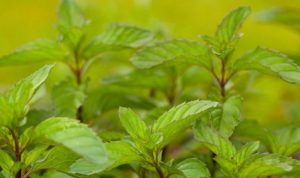
The mint species is highly cultivated due to its oils. The essential oil has a strong odor ideal for making perfumes.
Bergamont mint is native to subtropical regions and Northern India. The soft, minty, and citrus smell are the distinctive features.
The medicinal properties help reduce inflammation and relieve pain, and gas in the alimentary canal. The herbal tea can treat stomach pains, sore muscles, and nausea.
Scientific Name |
Mentha citrata |
Common Names |
Eau de cologne mint, orange mint |
Identification Features |
Soft, minty, and citrus smell |
USDA Zone |
5-9 |
Egyptian Mint
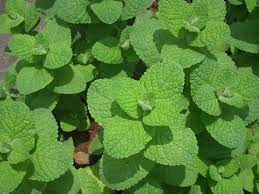
It is the actual mint plant according to the History of the Old Testament Bible. It is commonly used in culinary due to the scent that resembles apple mint.
The herb has a strong and upright stem with fuzzy leaves. It is the best suit for pots or containers since it can grow up to 3ft tall.
I recommend using this wild mint in savory dishes and teas. The medicinal properties make the mint species suitable for skin tones.
Scientific Name |
Mentha rotundifolia |
Common Names |
Egyptian mint |
Identification Features |
Upright stems with fuzzy leaves |
USDA Zone |
1-8 |
Ginger Mint
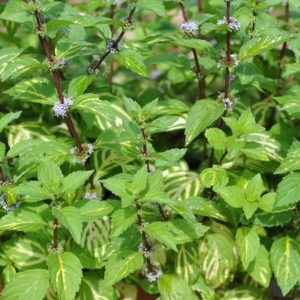
It is a cross between wild mint and spearmint. It is commercially grown due to the essential oils and spearmint flavors for making chewing gums.
The smell from the plant helps to ward off rodents around the grain stores. The ginger mint flavors are excellent for scotch spearmint chewing gums and candies.
In my culture, we use the leaves to add flavors to meat stew or grill. The medicinal properties help to heal digestive issues, headaches, and fevers.
Scientific Name |
Mentha x gracilis |
Common Names |
M. arvensis x M. spicata, redmint, Scotch spearmint, Scotchmint, Bushy Mint |
Identification Features |
Strong scent for warding off rodents |
USDA Zone |
5-9 |
Grapefruit Mint
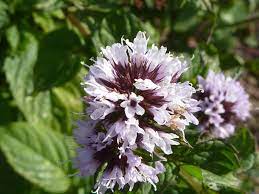
The mint type has a scent that resembles the grapefruit with mint mixture. The green leaves have fruity flavors and can be mixed with desserts, seafood, and lamb.
This upright herb can grow up to 2ft tall and produces lavender flowers. You can add the herb to salads, chicken, fish, and beef dishes due to the citrus flavors.
Scientific Name |
Mentha × piperita f. citrata ‘Grapefruit’ |
Common Names |
Grapefruit mint |
Identification Features |
Green fruity leaves with lavender flowers. |
USDA Zone |
6-11 |
Pennyroyal mint
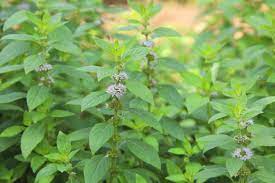
It is the most aromatic mint species ideal for cooking pork dishes and traditional medicinal purposes. Pennyroyal mints are native to Europe, the Middle East, and North Africa. Crushed leaves emit a strong odor like spearmint leaves.
The pungent and acrid flavors are suitable for wine, food, and herbal teas. The extracts from the herb can also stimulate menstruation or induce abortion.
We recommend not using pennyroyal herbs since research shows that the oil contains some toxins that are dangerous to human livers.
Scientific Name |
Mentha pulegium |
Common Names |
Mosquito plant, pennyrile, pudding grass |
Identification Features |
Pungent and acrid flavors from the leaves |
USDA Zone |
6-9 |
Horsemint
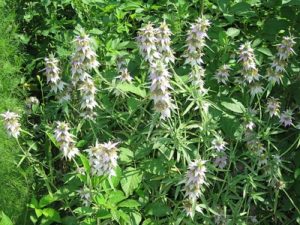
The mint grows up to 4ft tall and bears flower spikes with pale pink or lilac colors. The herb has close similarities with silver mint though it is mostly used in the medical industry.
The delicate lemony flavors are excellent for savory dishes and hot or cold teas. I recommend using the herb when cooking chicken or fish due to the lemon taste.
Scientific Name |
Buddleia Mint |
Common Names |
Silver mint |
Identification Features |
Flower spikes with pale pink or lilac colors |
USDA Zone |
4-9 |
Asian Mint

It is a hybrid species that occurs by crossing between silver mint and horsemint. The herb is native to Central Asia, Western Asia, and China.
The upright stems, few branches, and oblong-shaped leaves are the distinctive features for easy identification. The purple-red flowers and sepals are conspicuous.
The leaves from the Asian mint are ideal for making herbal tea. The medicinal properties help treat minor illnesses like fever or headaches.
You can also use raw or cooked leaves in salads and other cooked dishes. The flavors will make your food mouthwatering.
Scientific Name |
Mentha longifolia var. asiatica |
Common Names |
Mentha asiatica, Mentha asperata, Mentha kopetdaghensis, Mentha vagans |
Identification Features |
Oblong-shaped leaves and erected stems |
USDA Zone |
6-9 |
Australian Mint
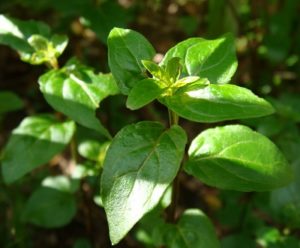
The herb is native to every state of Eastern Australia and some parts of New Zealand. It is soft, aromatic, sprawling, and upright posture.
The white or pink flowers and invasive traits are the distinctive features. Leaves are edible parts and can be eaten when raw, cooked, or dried.
The mint type tastes and smells like a combination of peppermint and spearmint. The peppery undertones make it ideal for adding to salads, tea, sauces, and cocktails.
Scientific Name |
Mentha australis |
Common Names |
Australian river mint, native peppermint, native river mint, river mint |
Identification Features |
Pink or white flowers |
USDA Zone |
6-7 |
Canada Mint
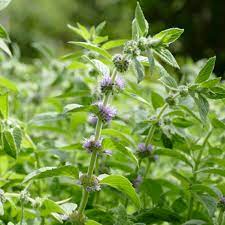
The mint species is native to North America and Eastern Asia. The leaves grow opposite each other on the upright stems.
The bluish or slightly violet flowers are the most conspicuous feature. The herb also has hairy stems and short leaf stalks.
The herb is highly cultivated across the world for methanol and essential oils. You can use dried, cooked or raw leaves.
The Canada mint is used in making mint jelly, mint tea, and mint leafy candy. I recommend using mint tea to eliminate bad breath, hiccups, or toothache.
Scientific Name |
Mentha canadensis |
Common Names |
American wild mint, East Asian mint, Sakhalin mint, American Cornmint |
Identification Features |
Bluish or slightly violet flowers |
USDA Zone |
3-7 |
Chinese Mint
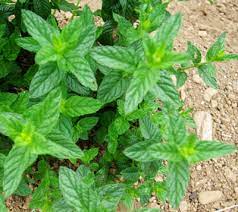
The herb is native to China and is mainly used to make herbal tea. The entire part of the plant is edible. The Chinese mint plant has pale lilac flowers and oval-shaped leaves with serrated margins for easy identification.
The herbal tea tastes pleasant and can be used to treat several illnesses like colds, sore mouth, toothaches, and fevers. The plant also has numerous culinary benefits.
Scientific Name |
Mentha haplocalyx |
Common Names |
China mint |
Identification Features |
Pale lilac flowers |
USDA Zone |
7-9 |
Dahurian Thyme
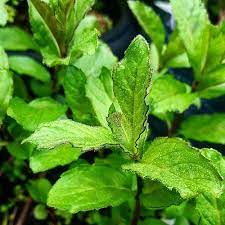
The herb is common in Japan, the Far East of Russia, Siberia, and some Northeastern parts of China. The vibrant scented flowers and strong-smelling leaves are distinctive features.
The low-growing plant is an excellent ground cover with numerous culinary and medicinal benefits. The essential oils are used for making antioxidant medicines.
Scientific Name |
mentha dahurica |
Common Names |
Not applicable |
Identification Features |
Scented flowers and strong-smelling leaves |
USDA Zone |
4-10 |
Garden Mint
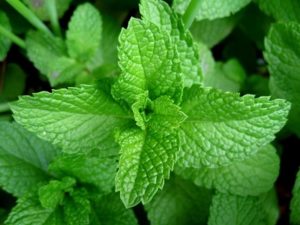
The mint species has small purple flowers and bright green aromatic leaves. The herb is excellent for culinary uses.
You can use the leaves to make mint sauces or add to flavor beverages and mint tea. It also has some medicinal properties for treating minor illnesses.
Scientific Name |
Mentha sachalinensis |
Common Names |
Not Applicable |
Identification Features |
Bright green aromatic leaves and small purple flowers |
USDA Zone |
6-9 |
Japanese Mint
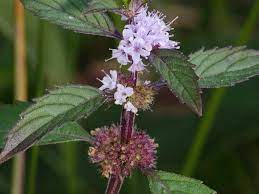
The mild fragrant herb has soft, hairy, and round leaves that smell like apples when touched or crushed. The small pale blue-purple flowers are distinctive features.
The smell helps repel harmful insects and attract potential pollinators into your kitchen garden. The essential oils have sweet minty aromas used in culinary and medicine.
Scientific Name |
Mentha arvensis var. piperascens |
Common Names |
American corn mint, brook mint, corn mint, Japanese oil of peppermint |
Identification Features |
Soft, hairy, and round leaves with pale blue-purple flowers. |
USDA Zone |
4-6 |
Large-Flowered Mint
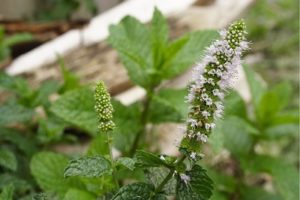
The mint species hails from the Eastern part of Australia. The small pale lilac-purple flowers and strong scents are the distinctive features.
The fiery bitter taste and unpleasant smell make this species not ideal for cooking. I once mistakenly used it in my soup and experienced nausea for a couple of days.
Scientific Name |
Mentha grandiflora |
Common Names |
Not applicable |
Identification Features |
Small pale lilac-purple flowers and a strong scent from the leaves. |
USDA Zone |
5 |
New Zealand Mint

The herb is native to New Zealand islands called Chatham Island, North Island, South Island, and Steward Island. The minty aroma is the reason behind its popularity.
The mint plant has slender and wiry stems with many branches. The broad leaves have short stalks and small white flowers.
The leaves from the herb are ideal for adding flavors to the food and inducing sweating or perspiration in the medicinal industry.
Scientific Name |
Mentha cunninghamii |
Common Names |
Mentha cunninghamia, hīoi (Māori), Māori mint, moki or mokimoki (Māori) |
Identification Features |
Small white flowers and broad leaves with short stalks |
USDA Zone |
6-9 |
Princess Mint
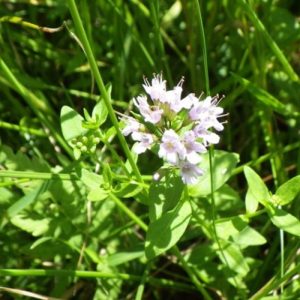
It is a small mint plant native to the Japanese Islands of Honshu and Hokkaido. The mint species is quite rare and the scent resembles the pennyroyal mint plant.
The flowers have white or pale violet colors due to different variegation. The mint is specifically ideal for the medicinal industry despite its aromatic nature.
Scientific Name |
Mentha japonica |
Common Names |
Not applicable |
Identification Features |
|
USDA Zone |
5-10 |
Royle’s Mint
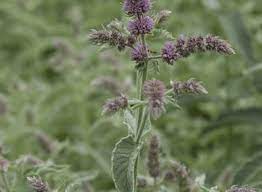
The mint species is native to Pakistan, Kashmir, the Himalayas, and Afghanistan. It is also grown in northwest Asia, Europe, and parts of China.
The narrow oblong-shaped leaves are discolored for easy identification. The leaves are attached directly to the stems without stalks and have slender spikes.
The small white flowers are other distinctive features. The herb is more commonly used in herbal medicine than in the culinary sector.
Scientific Name |
Mentha royleana |
Common Names |
Jangli podina, Kala podna, Nari wailani, Pahari pudina, Safaid podina, Tulasi paate, Valenay |
Identification Features |
Narrow and oblong-shaped leaves |
USDA Zone |
9-11 |
Silver Mint
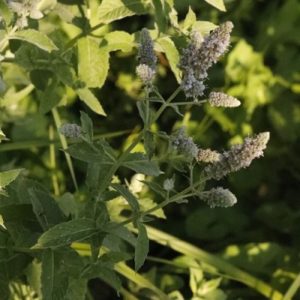
The mint type is native to west and central Asia, North and South Africa, and parts of Europe except Britain and Ireland.
The scent of the mint resembles that of peppermint. The herb contains antioxidant properties for healing tummy issues.
You can also use it to make herbal tea for soothing the throat, masking bad breath, and eliminating dandruff after combining it with vinegar.
Scientific Name |
Mentha longifolia |
Common Names |
Fillymint, horsemint, St. John’s horsemint |
Identification Features |
Long lilac, purple, or white flowers |
USDA Zone |
5-9 |
False Apple Mint
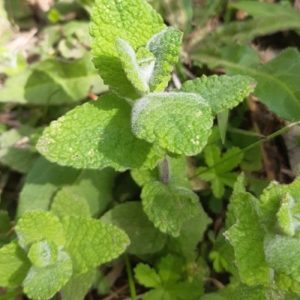
It is a hybrid mint developed by crossing between silver mint and apple mint. The herb is native to Northwest Africa, Europe, and Asia.
The leaves from the plant are ideal for cooking several dishes. Thanks to the savory and sweet flavors when added to salads, greens, sauces, grilled meat, and fruit drinks.
You can also infuse the mint flavors into tea, iced tea, and fruit juice. The herb contains medicinal properties for healing and preventing respiratory problems.
Scientific Name |
Mentha x rotundifolia |
Common Names |
M. longifolia x M. suaveolens, Mentha spicata var. rotundifolia, bigleaf mint |
Identification Features |
Savory and sweet flavors |
USDA Zone |
3-8 |
Lavender Mint
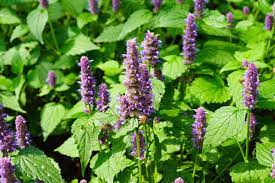
It is the most beautiful mint species and is highly grown for decoration purposes. The plant can grow up to 2ft tall in proper condition.
This versatile mint type has medicinal properties and flavors ideal for culinary uses. It is commonly used in tea, lip balms, creams, and shampoos.
Scientific Name |
Lavendula spp or Mentha piperita |
Common Names |
Mint lavender plant |
Identification Features |
Lavender flowers with whitish hues |
USDA Zone |
3-7 |
Pineapple Mint

The pineapple mint has leaves with a slight pineapple aroma. The herb can grow up to 25 to 60cm tall in proper condition.
The variegated green and cream-colored leaves are distinctive features. The slow-growing mint cannot tolerate extreme winter.
The pineapple flavors make this mint species an excellent option for desserts, punch, and cocktails. Besides that, the foliage colors mark a bold statement in a container.
Scientific Name |
Mentha suaveolens variegata |
Common Names |
Apple or wooly mint |
Identification Features |
Variegated green and cream-colored leaves with pineapple aroma |
USDA Zone |
5-9 |
Licorice Mint
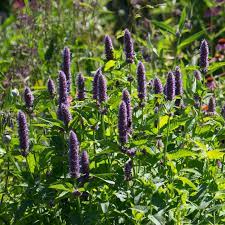
It is the tallest mint species since it can grow up to 4ft tall in proper conditions. It produces lavender and white flowers that attract birds due to bugs’ presence.
The herb has slightly sweet flavors that taste a little bit like real licorice. The fresh or dried leaves from the mint are excellent for culinary purposes.
I recommend adding the leaves to lean meat when cooking to enjoy the flavors. Another option is to make ice cream since it pairs well with fresh fruits. (Source: Specialty Produce).
Scientific Name |
Agastache rupestris |
Common Names |
thread-leaf giant hyssop, Mexican Hyssop |
Identification Features |
Lavender and white flowers with several bugs. The leaves are slightly sweet with a little bit of licorice taste. |
USDA Zone |
5-11 |
Strawberry Mint
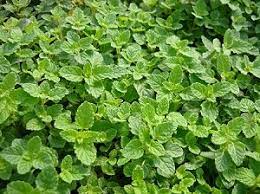
It is a rare mint species that taste nothing like mint. The strawberry flavor makes the herb suitable for making tea, lemonades, and cocktails.
The mint species can grow up to 30-50cm tall with pink bloom. The runners make the mint species invasive since they spread quickly.
Scientific Name |
Mentha species |
Common Names |
Not available |
Identification Features |
Red fruit taste |
USDA Zone |
5-10 |
Menthe de Perse Mint
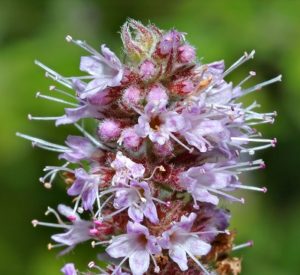
It is a type of mint native to the Atlas Mountains of Morocco. It is highly cultivated due to its essential oils that are used in traditional herbal medicine, pest control, and cooking.
The creeping herb has broad and sessile leaves that appear linear or oblanceolate in shape. The whitish-to-pale lilac flowers are distinctive features.
Scientific Name |
Mentha gattefossei |
Common Names |
“Fliyyo dial jbel” (Arabic), “Menthe de Gatefossé” (French) |
Identification Features |
Linear-shaped broad and sessile leaves with whitish to pale lilac flowers. |
USDA Zone |
6-7 |
Red Raripila Mint
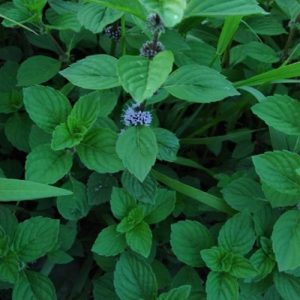
It is a hybrid species of water mint, spearmint, and wild mint plants. The herb is native to Northern and Central Europe.
The red raripila herb is an excellent companion plant for cabbages and tomatoes. The scent helps to prevent insect or pest infestations.
Scientific Name |
Mentha x smithiana |
Common Names |
M. aquatica x M. arvensis x M. spicata, Redstem Mint |
Identification Features |
Strong scent |
USDA Zone |
6 |
Slender Mint
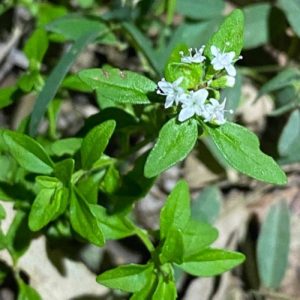
The mint species is native to Australia. But the herb is also grown in New South Wales, Queensland, South Australia, Tasmania, and Victoria.
The broad flat leaves have a strong mint scent when crushed. The leaves can also be hairy or hairless depending on the species with smooth or serrated margins.
The pink, mauve, purple, or white flowers are distinctive features. The slender mint has numerous culinary and medicinal benefits.
Scientific Name |
Mentha diemenica |
Common Names |
Not Available |
Identification Features |
Low-growing plant with matting stems and branches |
USDA Zone |
7-12 |
Spearmint
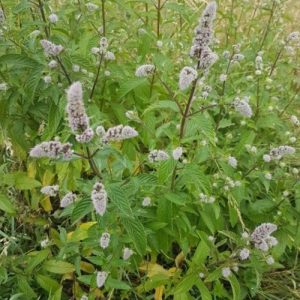
The mint type is native to Europe and other temperate parts of Southern Asia. The sweet delicate flavors are the reason behind its use in the culinary industry.
The minty odor with sweet hay-like undertones makes spearmint to be my favorite herb in the kitchen garden. Others say it tastes minty and carvone-like with weedy nuances.
The plant can also be used to treat bad breath, spasms, and flatulence. Doctors recommend using natural spearmint to balance hormones and reduce blood sugar.
Scientific Name |
Mentha spicata |
Common Names |
Mentha crispata, Common mint, curly mint, lamb mint, mackerel mint, native spearmint |
Identification Features |
Spear-shaped bright green leaves |
USDA Zone |
4-11 |
Native Pennyroyal Mint
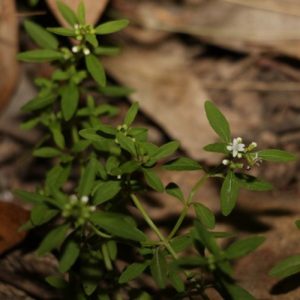
Native pennyroyal mint plant hails from New South Wales, Queensland, South Australia, Victoria, and Western Australia. It is an excellent grown cover since it grows in clumps.
The mint plant has small and delicate white flowers. The ingredients in the herb are ideal for culinary and medicinal purposes.
I use native pennyroyal mint to make salads, sauces, sorbets, and teas. It is also a traditional herbal medicine for relieving colds and flu.
Scientific Name |
Mentha satureioides |
Common Names |
Bush mint, creeping mint |
Identification Features |
Tiny white flowers |
USDA Zone |
5-9 |
Watermint
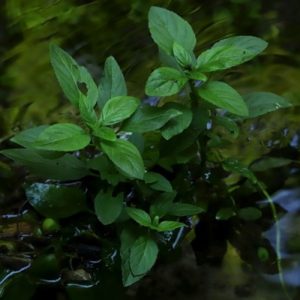
Watermint species are native to England, Ireland, Northern Ireland, Southwest Asia, and Northwest Africa. The herb has too much methanol to add flavors to different dishes.
The small colored flower petals and hairy or hairless green stems with broad green leaves are the distinctive features. The green leaves with purple undertones mark a bold statement.
The herb can be toxic to humans, dogs, cats, and horses if used in large quantities. I do not recommend it when preparing dishes or herbal teas.
Scientific Name |
Mentha aquatica |
Common Names |
Marsh mint |
Identification Features |
Small flower petals that are pink or lilac in color. |
USDA Zone |
5-11 |
Related Articles






